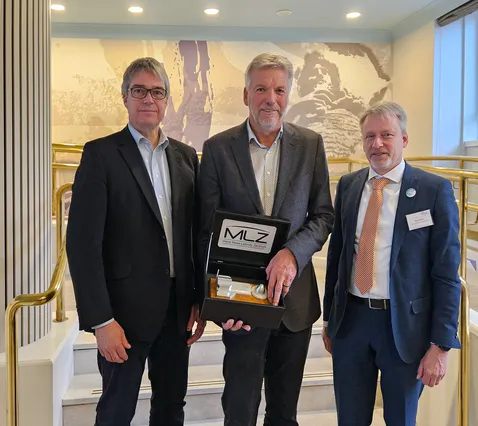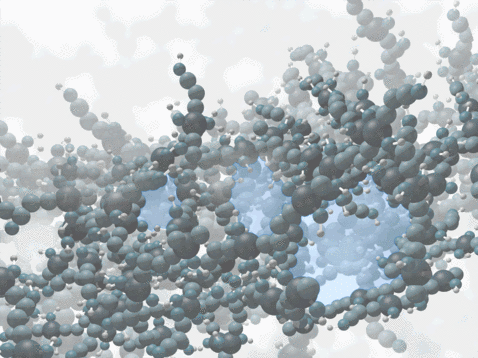News
MLZ Prize for ‘shooting star’ Prof. Günther Dollinger
Aktuell |

After four neutron prize winners, Günther Dollinger from the University of the Bundeswehr in Munich is now the first to be honoured for his services to the instruments at the MLZ positron source. Normally, the MLZ Prize is awarded during the university group leader meetings at the MLZ. ‘This time, we decided to present the award at the MLZ User Meeting to give it more visibility,’ Christian Pfleiderer explained.
Günther Dollinger studied physics at the Technical University of Munich, obtained his doctorate and later habilitated at the Maier-Leibnitz accelerator as a ‘shooting star’ in ion physics, as Pfleiderer reported in his laudatory speech. Since he was appointed Head of the Institute of Applied Physics and Metrology at the University of the German Federal Armed Forces in Munich in 2004, Günther Dollinger has been involved in the instrumentation of the positron source at the FRM II and MLZ. He explicitly promoted the further development of pulsed positron beams, which are necessary for lifetime measurements, in particular the Pulsed Low Energy Positron System (PLEPS) developed at his institute.
Teamwork leads to success
‘You can only achieve something like this if you work on it for many years with a good team,’ said Günther Dollinger, looking gratefully at his colleagues in the audience: Dr Werner Egger and Dr Marcel Dickmann, who are still working on instruments at the positron source, as well as Dr Gottfried Kögel and Dr Peter Sperr, who have already retired.
Among the guests of honour was the vice president, Prof. Dr Uwe Borghoff, and the former, long-standing President of the Bundeswehr University, Prof. Dr Merith Niehuss. In his plenary lecture, Dollinger then discussed the generation of positrons and their application in materials science.

From clean waste water to fusion reactors
Positrons, the antiparticles of electrons, can live forever in a vacuum. However, when they encounter an electron, these particles annihilate after a certain time, emitting a characteristic gamma ray. Positron Annihilation Lifetime Spectroscopy (PALS) utilises this property by measuring the lifetime of positrons in materials. Positrons survive longer in vacancies in an atomic lattice because there are fewer electrons there. If a positron enters such a vacancy, the scientists can recognise how large the vacancy is, depending on its lifetime. This is important, for example, when measuring pore sizes in membranes for wastewater filters (news report). The antiparticles from the MLZ also play a decisive role in the development of materials for fusion reactors: ‘We can test the defects in the atomic lattice in the heat-treated tungsten materials for the plasma walls. They have to be able to withstand very high radiation fluences and heat,’ explained Dollinger.
Resolution in the picosecond range
Dollinger is by no means resting on his laurels: ‘We have been able to increase the brilliance of the positron beam at the MLZ by a factor of 1000 with a specially developed remoderator,’ he says happily. And there are also plans for the future: In addition to the scanning positron microscope, which can visualise micrometre-sized defects in materials, the PLEPS instrument is also to be taken to a second generation with an even higher resolution in the 100 picosecond range. With the planned transfer of the instruments to the new Neutron Guide Hall East, Günther Dollinger's team is optimistic about the future and is ready to further advance materials research.

Previous MLZ prize winners:
2019: Prof. Dr. Götz Eckold
2020: Prof. Dr. Georg Roth
2021: Prof. Dr. Peter Böni
2022: Prof. Dr. Heinz-Günter Brokmeier
2023: Prof. Dr. Wolfgang Schmahl